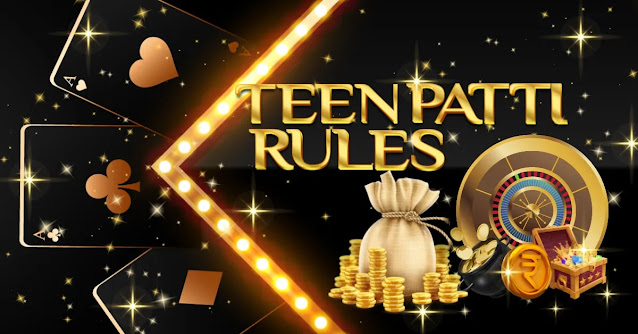How Could I Find Info for the Teen Patti Sequence Game?
Is the Indian card game Teen Patti something you're interested in trying but have some questions about?
Don't worry about it. You'll find the entire set of Teen Patti regulations in this post.
The Indian card game Teen Patti Sequence is incredibly well-known throughout the country. Keep trying to learn the rules of Teen Patti India and get a feel for the game.
The popularity of this card game, which has its roots in India, has spread over all of South Asia. It's a variation on Poker with three cards, called "flash" or "flush."
Learn How to Play Teen Patti Game and the Rules
The Desi card game Teen Patti is played with a standard 52-card deck with three to six players. Starting with a token in play is standard procedure in Teen Patti India, much as in other rummy and poker variants. Participants must agree on an initial bet amount before any cards are dealt.
When everyone has finished placing their tokens, and the total has been tallied, the dealer will deal three cards to each player face down. The initial supply of tokens, known as the "boot sum," is always included in any token-based game. In this case, the table is where you'll find the pot.
The following action is to call or raise once each player and the sellers have received their initial three cards. These are terminology you should be aware of if you've ever played Poker, a popular card game in India. Calling signifies continued play but no increase in the player's token; raising signals the player will add the token to the pot; play to win or lose more than the player's starting gaming token.
Teen Patti is a popular card game in India, but it's vital to remember that it's not the same as Poker. Token quantities in the Teen Patti app must always be divisible by two; thus, if one player bets two coins and another bets four, the first player must add four coins to the earlier two bets.
A growing pot rewards those who can ride it out until the end of the hand with the best hand. The cards are ranked in order of importance, and that determines the winner.
Hand Ranks: 3 Patti Rules, A Popular Desi Card Game India
Teen Patti is a popular online card game in India, and victory requires having a higher value hand than your opponents. The following is a ranking of the 3 Patti hands, often known as sequences.
Trail Rr Set (three of the same rank)
Three identical cards of any color or suit can form a trail, set, or trio in Teen Patti. For instance, this hand's highest possible combination of cards consists of three Aces, one club, one diamond, and one heart.
The same is true of the different ranks occupied by three Aces of the same suit (Ace of Clubs, Ace of Diamonds, Ace of Hearts). It's a tie between the Queens, Jacks, 10s, and the remainder. A pair of 2-2-2s is the worst possible pair.
Pure Sequence Or The Straight Flush
Teen Patti players in India refer to this particular sequence of three hands as the "pakki round." Three cards in a row all share the same suit. In the standard game, an A-2-3 of hearts, diamonds, spades, or clubs is the highest possible ranked hand in a pure sequence.
In other contexts, though, A-K-Q takes precedence. The final digits of the sequence, 4-3-2, are ranked the lowest. If you're keeping track, you'll see that the sequences 2-A-K and K-A-2 are invalid.
Sequence (straight or run)
A run or linear sequence in Teen Patti is the equivalent of a pure sequence in other games. The hand consists of three consecutive cards of different suits. This same A-2-3 combination is the best possible hand in the classic version of the game as well.
However, with the tweak, the sequence becomes A-K-Q. As the series progresses, the 4-3-2 hand is the worst possible result. The straight sequences 2-A-K and K-A-2 are not possible.
Color
In the card game Teen Patti, a color or flush consists of three cards of the same suit that are not in sequence. Here, the highest-ranking hand is A-K-J of spades, clubs, diamonds, or hearts, followed by A-K-10, A-K-9, and so on. Color or flush sequence 5–3–2 is the worst possible hand.
Pair (two cards of the same rank)
In the card game Teen Patti, a pair or double consists of two cards of the same rank, regardless of color or suit. Two Aces of any color or suit are Teen Patti's highest pair. When two or more players are dealt a pair of identical cards, the highest-ranking hand is determined by the value of the third card.
Sequences of A, A, K, and 2-2-3 are at opposite ends of the rankings.
High Card
Patti, a teenager, has a high card that looks like a flush. The hand is made up of three random cards of different suits. A-K-J is the highest possible hand, while 5-3-2 is the lowest. If two players have the same high card, the next highest card is used to decide who has the better hand.
Start The Game
Watch this video to obtain an overview of Teen Patti's rules before diving into the finer points.
Rounds Of Gaming
Chaal is a well-liked Indian card game, and you have the option of playing it either by sight (looking at the cards) or by blind (putting your token without seeing the other players) before you do so (not seeing the cards).
In blind Poker, you must bet at least the ante but no more than double the ante. For instance, if the ante is 15, you'll need to put in at least 15 tokens to play. The maximum number of tokens per wager is 30.
Chaal is a common card game in India. However, it would help if you doubled your bet to keep playing against blind players. In any case, you must only wager up to four times the total.
The following rules apply to the entire round of the Indian card game popular in the United States, known as "Desi."
Every time you place a token from now on, you have the option to either call or raise:
The cost of a call equals the sum of the most significant tokens from each round times the total number of rounds played.
An increase occurs when one player's token total surpasses every other player's. In the game of Chaal, you can only play with four of the highest-valued tokens at a time. When playing blind, you are limited to playing just twice the highest token.
Gameplay will continue until one of the following conditions is met:
Everyone else had given up and left the table. You win the entire pot if you're the only one who didn't fold.
All but two of the players in the hand fold. In such a scenario, one of the two surviving players may initiate a show request. Both players must reveal their hands and compare their cards if this occurs. Whoever holds the best hand at the end of the game wins.
The Show
When everyone but the last two players has folded, the last two standing may decide to have a showdown. In this instance, both players must show their hands. The guidelines for this program are as follows:
The last showdown takes place when there are just two contestants left.
Both remaining players may now request a show if they like. They need to put an amount equal to one time to the current one.
No one, not even the dealers, may look at their cards before the show is paid for.
Any final two players may initiate a show if they so want. Each of them will double the token price.
Any player can be asked to perform for a blind player.
The blind token's value must equal the current token multiplied by 1. Players who are blind are required to double their bets.
A show cannot be requested by a player who is blind. Ultimately, the player can only participate or withdraw from the game.
Cards are shown to both players during the show. After a game of Poker, the pot is awarded to the player with the best five-card hand.
In the event of a tie, whoever paid for the show goes home empty-handed.
The victor moves up to the position of dealer for the next round.
Compromise
Asking for a compromise, often known as a sideshow, is a valid option if you're playing Chaal. The steps to reach an accord are as follows:
Before the game, each player must make a mandatory initial bet (Ante).
When you turn to put a token, you can negotiate a trade with the player placed before you (the person to your left). The previous player must be playing Chaal for this to work.
The current amount from the player before you would be the finest choice to place.
The opposite party may choose to accept or decline the proposed settlement.
If the other player agrees to the compromise, you must show each other your cards. When a player has a weak hand, they must fold. If both players have equal cards, the one who asked for a compromise should give up.
If the other player refuses the proposed settlement, play continues with the next player.
Check out our website Hobigames if you want to learn and discover more things about this.



Mga Komento
Mag-post ng isang Komento